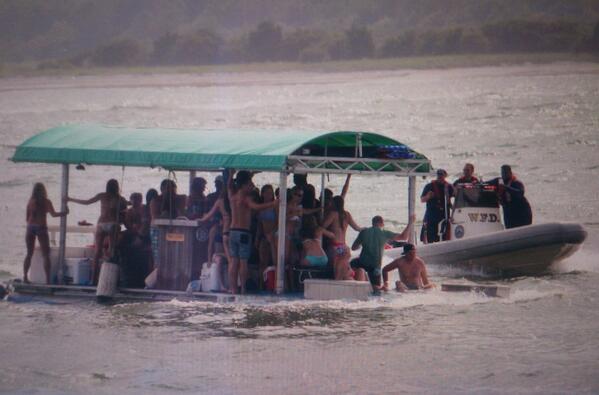Stuart DeSpain
Member
I’m new to owning a pontoon boat so still getting my “lake legs” under me.
Today I was out on my Bennington GBR 2250 at close to max capacity. I was boating through a cut between two lakes at around 7kts. I was distributing the weight reasonably well but a couple times, while behind another boat, the bow was pulled down and a lot of water swamped the deck. I guess this is called “submarining”.
I had everyone move to stern and turned around as I was concerned the choppy lake conditions weren’t conducive to safe boating. My passengers weren’t entirely thrilled but – even with PFDs on - I was not taking chances.
I’m looking for advice on how to better manage such conditions in future. For example, how alarmed should I be? The final swamp was severe enough to lift the prop out of the water. That seems serious to me but, being new, maybe that’s just me being paranoid.
How do others manage submarining? I read that hitting the wave at 45-30° helps as does working the throttle but both options would have been hard to execute in the cut.
Thanks for your wisdom and advice!
PS - boat and load specifics:
24’ GBR 2250 with two pontoons, 70hp Yamaha outboard; max load is 1487lbs (engine weight accounted for).
This outing had six adults and one child. Some adults are heavy (myself included). With gear I’d estimate that we were tipping 1300lbs. Weight was distributed with two adults at stern, two midship, and two in the bow. Heavier adults were towards the back. Child was, as children will be, free-roaming.
The Montlake Cut is a very narrow passage from one lake to another. It’s generally ~30ft deep with some shallow parts. It’s about 100’ wide at the narrowest point. Boat density is high, with around 20 or so boats passing through the cut with us. This results in lots of water churn bouncing off the concrete walls. Boat density makes it difficult to attack waves at any angle as there is limited room for maneuvering; same goes for acceleration.
The wake that first swallowed us was created by a wide and low ski boat. It was going slow but left a very deep, wide wake behind it. The second submarining was just the result of a lot of crossing wakes from folks coming in a little too fast.
I hope the context helps folks see the situation. Here’s a picture that’s pretty representative of the cut:

Today I was out on my Bennington GBR 2250 at close to max capacity. I was boating through a cut between two lakes at around 7kts. I was distributing the weight reasonably well but a couple times, while behind another boat, the bow was pulled down and a lot of water swamped the deck. I guess this is called “submarining”.
I had everyone move to stern and turned around as I was concerned the choppy lake conditions weren’t conducive to safe boating. My passengers weren’t entirely thrilled but – even with PFDs on - I was not taking chances.
I’m looking for advice on how to better manage such conditions in future. For example, how alarmed should I be? The final swamp was severe enough to lift the prop out of the water. That seems serious to me but, being new, maybe that’s just me being paranoid.
How do others manage submarining? I read that hitting the wave at 45-30° helps as does working the throttle but both options would have been hard to execute in the cut.
Thanks for your wisdom and advice!
PS - boat and load specifics:
24’ GBR 2250 with two pontoons, 70hp Yamaha outboard; max load is 1487lbs (engine weight accounted for).
This outing had six adults and one child. Some adults are heavy (myself included). With gear I’d estimate that we were tipping 1300lbs. Weight was distributed with two adults at stern, two midship, and two in the bow. Heavier adults were towards the back. Child was, as children will be, free-roaming.
The Montlake Cut is a very narrow passage from one lake to another. It’s generally ~30ft deep with some shallow parts. It’s about 100’ wide at the narrowest point. Boat density is high, with around 20 or so boats passing through the cut with us. This results in lots of water churn bouncing off the concrete walls. Boat density makes it difficult to attack waves at any angle as there is limited room for maneuvering; same goes for acceleration.
The wake that first swallowed us was created by a wide and low ski boat. It was going slow but left a very deep, wide wake behind it. The second submarining was just the result of a lot of crossing wakes from folks coming in a little too fast.
I hope the context helps folks see the situation. Here’s a picture that’s pretty representative of the cut:

Last edited:

